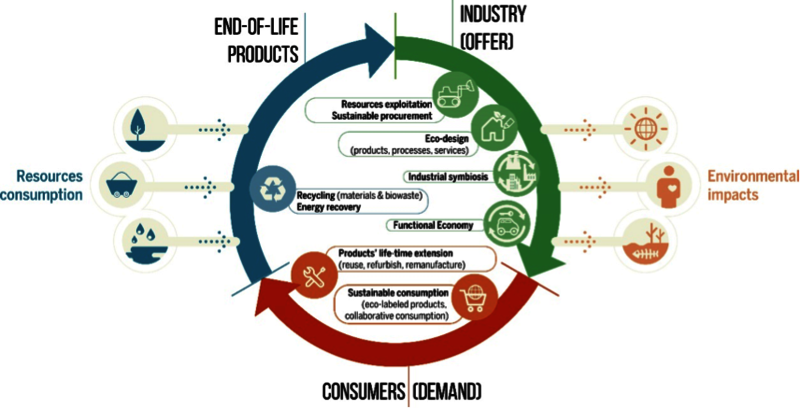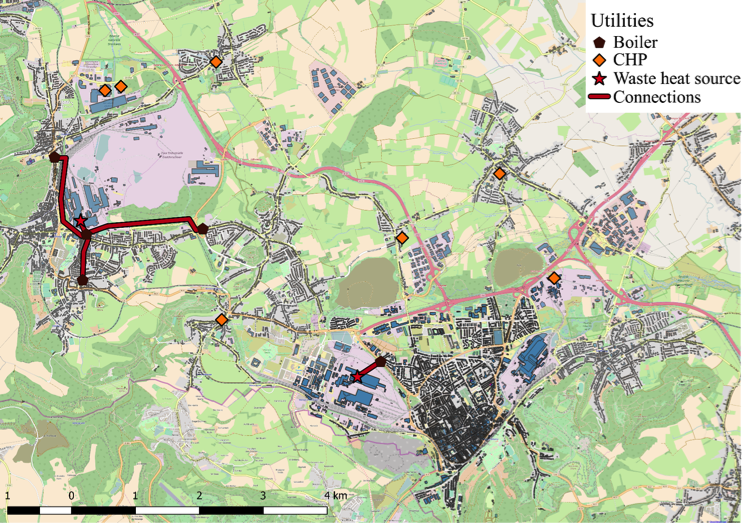Energy and Circular Economy at LIST
Published on 26/11/2018
Circular Economy (CE) has gained, over the last years, a very strong interest from both public and private actors in Luxembourg. While the focus is, so far, mostly on the sustainable valorisation of material resources, the production and use of energy are also key aspects of the multiple facets of CE (Figure. 1).

Figure 1: LIST’s vision of Circular Economy
Energy and circular economy
In a 2018 report relating circular economy to the energy sector in Finland, Deloitte identified three main topics: the natural resources exploitation for energy production, the energy consumption of end-users, and the recovery of waste heat.
Regarding energy production, the use of finite, natural resources needs to shift to renewable sources. While the use of those sources is increasing, several major hurdles still need to be overcome before our energy production can be 100% based on renewables: adaptation of the grid infrastructures to the new requirements, limited potential in given geographical locations, etc. One of the major challenges is how to handle the fluctuation of renewable sources in accordance to the demand side. Our energy systems need much more flexibility and appropriate structures, so that renewable energy, when available, is fully valorised.
Although these sources are continuously renewed, they should still be used efficiently. Sustainable, efficient energy consumption implies that the energy production plants are adapted to the final demand. Reducing losses to a minimum leads not only to an efficient use of renewables, but also to smaller plants and therefore reduced investment and operating costs. A high level of energy efficiency of our appliances as well as industrial processes are therefore necessary to allow the sustainable deployment of renewable energy systems. But process optimisation is a complex task, requiring an integrated approach (and thus appropriate quantitative assessment tools) to make sure that the whole system is indeed more efficient.
Finally, when the efficiency of these processes cannot be further improved, opportunities to still valorise the remaining wasted energy needs to be assessed. Particularly when considering excess heat recovery, first theoretical assessments estimated that approximately 90% of the EU residential and service sectors heating demand could be covered by waste heat from industrial and other sources. However, such valorisation is also constrained by multiple barriers: lack of information relating to available excess heat, economic viability in competition with other heating alternatives, complexity due to the large number of variables to consider, etc.
The Luxembourg Institute of Science and Technology (LIST) already addressed several of these challenges in the past.
LIST’s contribution to energy-related topics in a circular economy framework
Concerning waste heat valorisation, LIST contributed in the past to the development of a software targeting industrial process optimisation and heat recovery (www.einstein-energy.net). It developed models for the quantification and spatial allocation of domestic heat demand and waste heat potential, resulting in the first online GIS tool on this topic in Luxembourg. A complementary database of heating and cooling industrial streams was also set up at a later stage. In the framework of a PhD thesis, an optimisation method (OptiHeat) maximising profits from the best waste heat valorisation opportunities was prototyped. The method was specifically formulated for energy service companies, and demonstrated that such valorisation is viable in Luxembourg (Figure 2).
 Figure 2: Outcome of OptiHeat when applied to the South of Luxembourg, with heat recovery opportunities from the ArcelorMittal’s production sites
Figure 2: Outcome of OptiHeat when applied to the South of Luxembourg, with heat recovery opportunities from the ArcelorMittal’s production sites
LIST also collaborated with industries on the topic of process efficiency, such as Kronospan in Sanem. In the project “Factory of the Future”, LIST supported the company with its Life Cycle Assessment competences to reach its targets of improved energy efficiency. Multiple energy efficient measures were assessed and, when deemed relevant, implemented. In parallel, the use of waste wood as fuel was able to increase due to better preparation of the biomass.
LIST has been working on the use of renewable energies for many years, mostly relating to biomass and photovoltaic (PV) systems. In past years, the focus was on the performance characterisation of PV systems under real outdoor conditions, with LIST setting up its own outdoor test field. To address supply fluctuation of PV systems, a forecasting model predicting the power feed-in was also recently developed. Smart grids systems, necessary to reach the 100% renewables goal, were also targeted. For example, grid optimiser prototypes increasing the renewable share in electrical systems were developed. Multiple control options increasing the hosting capacity of distribution grids were assessed in a project with Sudstroum.
With the creation of the Sustainable Energy System group (see inset), LIST will further focus on Smart Grid management systems supporting the deployment of renewable energies in the electrical grids. In a collaboration with the energy provider Electris, the forecasting methods for PV systems will be further improved. As part of the Combi-Cast research project - funded by the Luxembourg National Research Fund (FNR) - artificial intelligence methods will be deployed to combine three different forecasting models depending on weather conditions, time of day, and other factors, in order to increase the reliability of the forecast. In the framework of the recently FNR-funded gENESIS project, an energy management system in near-zero energy buildings will be developed. Based on mathematical programming, optimisation models for the design and operation of the utilities (smart appliances, storage system, etc.), integrated into smart power grids, will be formulated and prototyped.
In the mid-term, follow-up research ideas will be further explored (e.g. on the use of truck-mounted storage systems for rural heat management, or the production of electricity from waste heat). As such, LIST will continue to fulfill its role as RTO providing concrete decision-support tools and prototypes to the energy sector and end-users, while embedding this in the circular economy transition necessary for a sustainable development of our society.
Sustainable Energy Systems (SES), a new research group at LIST: Since early 2018, LIST is home to a new research group, focusing on smart, sustainable energy systems. The team is growing quickly and will welcome its new group leader in 2019. Additional competences on ICT, as the backbone of the future smart grid, will therefore strengthen the current group in the coming months. |
Figure 2 : Reprinted from Energy, Vol 167, A. Bertrand, A. Mian, I. Kantor, R. Aggoune, F. Maréchal, Regional waste heat valorisation: A mixed integer linear programming method for energy service companies, Pages 454-468., Copyright 2018, with permission from Elsevier.
Share this page:








